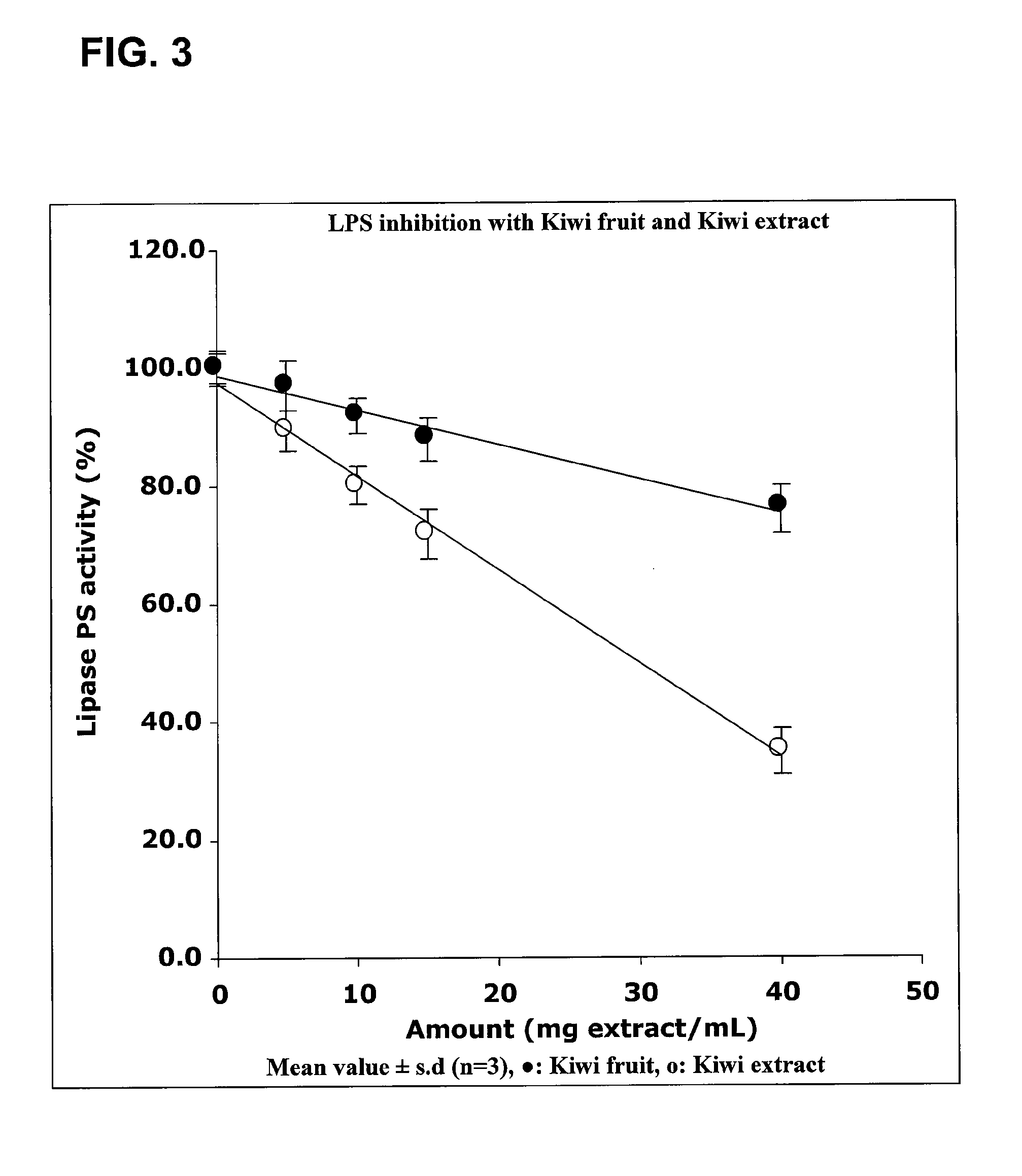Kiwi Extract
a technology of kiwi and extract, which is applied in the direction of plant ingredients, biocide, plant growth regulators, etc., can solve the problems that inhibiting the fas in healthy, non-obese humans is considered generally not to be an effective way to reduce the fat content in the body
- Summary
- Abstract
- Description
- Claims
- Application Information
AI Technical Summary
Benefits of technology
Problems solved by technology
Method used
Image
Examples
example 1
Preparation of Kiwi Fruit Extract
[0122] 1,000 kg fresh kiwi was ground and pressed. 350 kg of juice was obtained. 650 kg residue was obtained as raw material. 3,500 liters of 80% ethanol (aqueous ethanol) as solvent was added to the raw material at room temperature (20° C.) and the mixture was stirred for one hour. The extracted was filtered. The residue of the raw material was further extracted with 3,500 liters 80% ethanol at room temperature (21° C.) for one hour. The extracted was filtered. The two extracts were combined with the pressed juice and then concentrated to about 600 liter at 42° C. under reduced pressure (−0.085 Mpa). 12 kg Beta-cyclodextrin were added to the concentrate with stirring until the cyclodextrin was fully dissolved. 62.5 kg powder of coated Kiwi extract is obtained upon spray drying.
[0123] The extract was found to contain 5.0% actinidines with a biological activity of 113,000 IU / g. According to Folin-Ciocalteau assay methodology, the amount of total pol...
example 2
[0124] 1000 kg fresh kiwi was ground and pressed and 600 kg residue was obtained as raw material. 600 g of juice was obtained. 2500 liters of 90% ethanol as solvent was added to the raw material at room temperature (20° C.) and the mixture was stirred for two hours. The extract was centrifuged. The residue was further extracted with 2500 liters 890% ethanol at room temperature (19° C.) and the mixture was stirred for one hour. The extract was centrifuged. The extracts were combined with the pressed juice and concentrated to about 650 liters at 40° C. under reduced pressure (−0.090 Mpa). 10 kg Beta-cyclodextrin were added to the concentrate with stirring until the cyclodextrin was fully dissolved. The concentrate was lyophilized to afford 61.2 Kg powder of coated kiwi extract.
[0125] The extract contained 4.8% actinidines with a biological activity of 113,000 IU / g. According to Folin-Ciocalteau assay methodology, the amount of total polyphenols was greater than about 10% (m / m), the a...
example 3
Determination of Free and Total Polyphenols
[0126] Preparation of Kiwi Samples:
[0127] Fresh kiwis (including the skin) were cleaned, mixed thoroughly, chopped into fine particles and freeze dried at −20° C. under vacuum for 48 hours. The lyophilizate was powdered and used in the following experiments.
[0128] For the preparation of kiwi extract, fresh kiwi fruits were pressed. The residue was extracted twice with 80% ethanol (ratio residue / ethanol 80%=1 / 5) at room temperature for 2 hours. The ethanolic extracts were combined with the juice and evaporated to dryness under reduced pressure at 42° C. Starting from 10 kg Kiwi fruits, 0.50 kg of dried powder extract was obtained.
[0129] Extraction of Free and Total Polyphenols:
[0130] 1.0 g of lyophilized kiwi fruit or kiwi extract (as produced above) was mixed with 25 ml methanol / water (1 / 1 v / v) and heated to 90° C. in a plastic screw-capped tube with intermittent shaking for 2 h to determine the free polyphenols present in the correspo...
PUM
| Property | Measurement | Unit |
|---|---|---|
| Percent by mass | aaaaa | aaaaa |
| Mass | aaaaa | aaaaa |
| Substance count | aaaaa | aaaaa |
Abstract
Description
Claims
Application Information
 Login to View More
Login to View More - R&D
- Intellectual Property
- Life Sciences
- Materials
- Tech Scout
- Unparalleled Data Quality
- Higher Quality Content
- 60% Fewer Hallucinations
Browse by: Latest US Patents, China's latest patents, Technical Efficacy Thesaurus, Application Domain, Technology Topic, Popular Technical Reports.
© 2025 PatSnap. All rights reserved.Legal|Privacy policy|Modern Slavery Act Transparency Statement|Sitemap|About US| Contact US: help@patsnap.com



